What is a Hybrid Call Center?

The idea of a hybrid call center might sound counterintuitive. It would seem that employees fielding inbound and outbound calls and handling operations might have to be centrally located, but the call center model is evolving. There are many issues and challenges that call centers face when it comes to efficiency. However, most of them can be addressed with proper technology, training, and most of all, design. There are several ways that a hybrid call center can work efficiently.
What is a Hybrid Call Center?
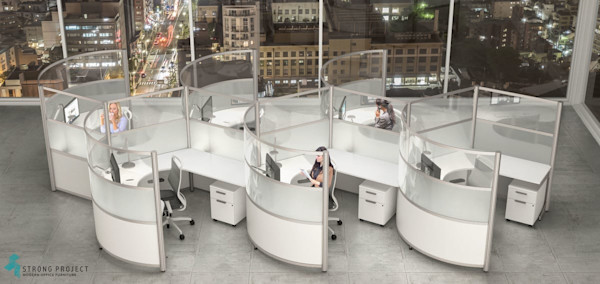
>>Are you designing your hybrid call center? Find our product collection here.<<
People who have never worked in a call center or who have never seen what is required to run a successful one, might not understand the problems that employees, managers, and executives face. Call center structures can vary, but ultimately, the models are very similar. The main point of contact for the call center is the agents. Above them are the supervisors. Above that the manager, and lastly the center is run by a director. This structure can be replicated across inbound and outbound departments as well as off-site. However, the way a center divides its operations can have a great bearing on productivity.
Hybrid call centers focus on both in-person and off-premise models. There are several benefits to embracing both models. Incorporating on-site and off-site agents into one call center model can help improve scalability, and adaptability, ultimately reducing operation costs. One of the most important parts of including off-site agents in a call center is cloud-based technology. This is vital to the center’s success. Although the technology might require an initial investment and training costs, the benefits of using this strategy can help in the long run. Let's look at the benefits of including off-site agents.
The Benefits of a Hybrid Call Center
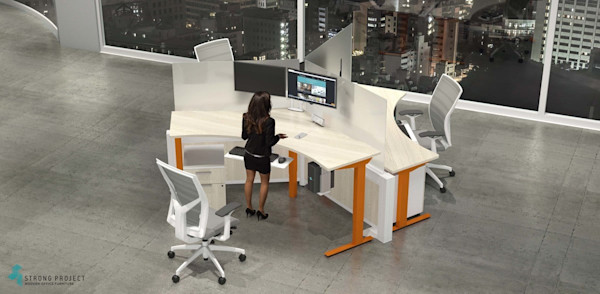
>>Are you looking for aesthetics and functionality? Find it here.<<
As with any business or office design, there are pros and cons. Some companies can operate efficiently and cost-effectively only using the on-site model, while others might look for opportunities to grow. There are several benefits that might make this model worth it.
Technology
The technology used in a hybrid call center can allow agents to access data anywhere. Cloud-based technology lets employees work anytime which can increase access to customers. Webex showcases the benefits of cloud-based technology and how it's being used in hybrid call centers. Making information accessible allows companies to outsource and scale as they need, without having to grow their physical location. Doing this streamlines the entire process and increases how effectively off-site and on-site employees can communicate and work together.
Scalability
Another important benefit of the hybrid model is the ability to scale at a relatively low cost. Although there are costs associated with hybrid call centers that you won’t find with the on-site model, companies can grow and reduce the size of their operation without having to increase or decrease office size. This is a pro that can safeguard companies should they encounter disasters such as the COVID-19 pandemic. Call centers that used the hybrid model during this time were able to continue their operations without being as negatively impacted as the traditional model.
Work-Life Balance
One thing most employees learned from the pandemic was how they preferred to work. Working remotely allows workers to work from home without dealing with the stressors found in the office. Continuous employee monitoring, wasted commuting time, and rigid work environments were just a few of the aspects of on-site work that employees were able to escape. Working remotely was an opportunity for people to improve their work-life balance and learn they were able to work without having to experience certain elements of their jobs they didn’t like. But this doesn’t necessarily mean call centers can’t provide on-site agents with what they need and improve the overall in-person work experience.
The Traditional Model

>>Visit our product collection to find customizable cubicle options.<<
Even though the hybrid model includes off-site agents, it also includes in-person work. If a company embraces the hybrid model, it shouldn’t neglect the on-site operations. Providing onsite agents with what they need to have a positive work experience should remain a focus. A call center office design is very unique. The center usually houses a large number of agents. This means that workers are subjected to cramped working spaces, bland designs, and relatively poor working conditions.
he work-life balance that remote agents experience is lost on in-person employees. They can’t work from the comfort of their home, they still have to commute, and they have to work in an environment that might not be suitable for them. Neglecting in-person agents can affect their performance which has the potential to lead to poor customer service. And in a job where customer service is most important, this can have a huge impact on the call center itself. An article by Small Business Coach highlights the problems that poor ambiance and working environment can impact productivity. Here are 3 ways companies can accommodate on-site call center agents:
The Layout
A call center can be a very busy environment. However, the way you design your center has a bearing on your employee’s success. Call centers often handle sensitive information specific to the customer. That, along with the need for exceptional customer service requires an environment that supports focused work. The layout and design of the call center can determine how well employees can protect information and provide a positive customer experience.
A traditional call center’s focus is to include as many employees as needed in one space. This typically results in rows of cubicles. This open floor plan and cubicle layout might be functional and have its pros, but it’s lacking a few key elements. Rooms lined with cubicles don’t usually have the best aesthetic or atmosphere. Poor design and layout can lead to a decrease in productivity, mood, and overall performance. Filling a space with functional yet aesthetically pleasing spaces can improve performance and create a better working experience for the employee, which in turn increases the likelihood of a more positive customer interaction.
Call Center Furniture
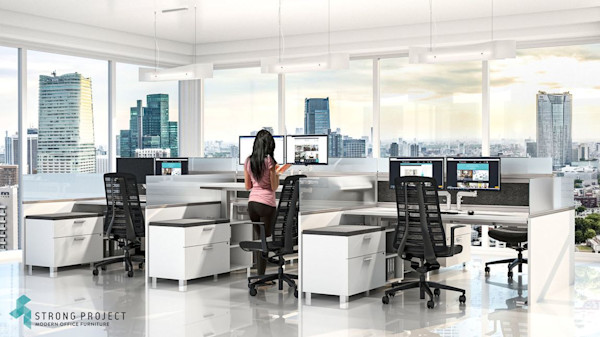
>>Our office task chairs are the perfect addition to any modern cubicle.<<
When designing a call center, one of the biggest decisions is furniture choice. Companies want the ability to accommodate a large number of agents, but how they do it is a delicate balance. You might think it’s impossible to avoid the sprawling cubicle farms, but that’s far from the truth. There are solutions to incorporate aesthetics and functionality into one space. The answer? The modern cubicle.
StrongProject’s hallmark modern curved cubicles can provide the environment that companies need and agents want. Our curved cubicles provide agents with the necessary privacy while avoiding the typical, bland cubicles. One of the best parts about incorporating our modern curved cubicle into your design is that you don’t have to sacrifice area to improve the feel and mood of a space. The way our curved cubicles are designed, we’re able to provide workstations that can set agents up for success, while reducing the wasted space found in the traditional, boxy cubicle. The nesting appearance of our pieces in our modern cubicle collection creates a sufficient workspace, and a pleasing aesthetic, and allows room for a more customizable design experience.
Ergonomics
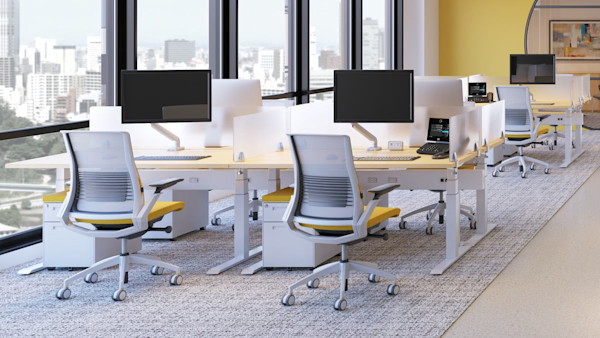
>>Our ergonomic chairs provide comfort as well as support.<<
Call center agents often find them sitting at their desks for long periods with little time away from their workstations. This can have many negative health implications, resulting in fatigue, decreased productivity, and even long-term health issues. Although the long work hours of fielding outbound calls and making inbound calls are inevitable, the way you help call center agents work can help reduce or even mitigate health risks.
A study by the Mayo Clinic addressed the impact that the sedentary work environment can have on workers. It can lead to poor circulation, depression and other mental issues, and even weight gain. These are only a few of the problems agents might encounter. Ergonomically designed furniture can help provide support for employees – literally and figuratively. Comfortable and supportive task chairs are one of the easiest ways to improve your employee’s working experience. The lasting effects of a poorly designed office chair can create discomfort in the moment and lead to long-lasting effects. Ergonomically designed chairs offer improved back support, posture, and multiple working configurations.
A trend that has grown in popularity over the years and is continuing to grow among the health-conscious is adjustable height desks. Adjustable height desks not only change the level of the working surface to improve posture, but they also allow employees to work in a standing position. This standing position helps combat the lack of movement that comes with the job. Strong Project’s adjustable height desk collection provides standalone desks and more importantly, the ability to stand while working in our cubicles. Ergonomics in a call center can help employees work for extended periods while avoiding discomfort and lasting health problems.
Is the Hybrid Model the Right Choice?
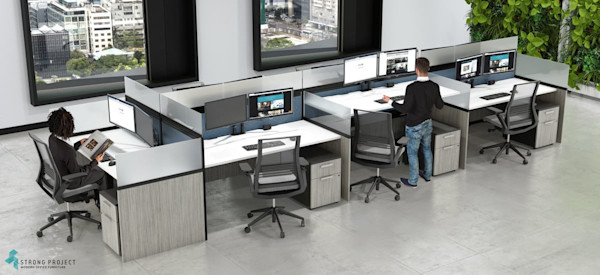
>>View our product collections and start designing your hybrid call center.<<
Deciding whether or not you should embrace the hybrid call center model depends on the type of work, agents, and goals. A lot goes into this decision and transition. For companies who want to grow, the hybrid model might be ideal. Other companies might be operating efficiently at their current capacity and do not need to grow. Deciding to embrace the hybrid call center should not come at the cost of on-site agents. Keeping a balance between both types of agents is important, and setting them up for success is key to a company’s success.
Take the first step towards revolutionizing your call center experience by exploring our product collections today.
Want to learn more about the hybrid workplace? Check out our comprehensive guide.



